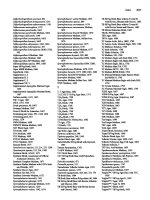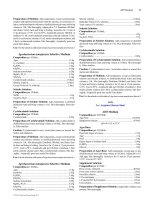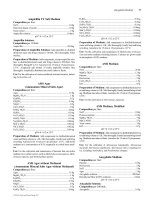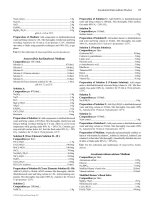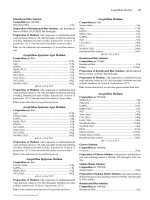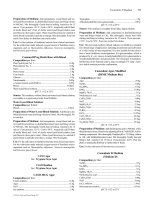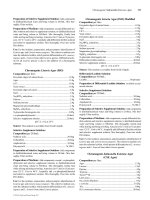Handbook of Small Electric Motors MAZ Part 14 doc
Bạn đang xem bản rút gọn của tài liệu. Xem và tải ngay bản đầy đủ của tài liệu tại đây (1.16 MB, 24 trang )
CHAPTER 7
SYNCHRONOUS MACHINES
Chapter Contributors
Chris A. Swenski
William H. Yeadon
7.1
This chapter covers some of the ac synchronous motors commonly encountered in
the industry. While it could be said that the electronically commutated motors dis-
cussed in Chap. 5 are also synchronous motors, this chapter is confined to the typical
ac versions.While larger polyphase machines are well covered by others, little infor-
mation is available on these smaller motors.
7.1 INDUCTION SYNCHRONOUS MOTORS*
These motors are built in a manner very similar to that for induction motors. They
may have polyphase windings or be designed as single-phase motors, such as
capacitor-start, split-phase, or shaded-pole types.
The rotors have a dual construction that allows for induction motor starting char-
acteristics and salient-pole synchronous running conditions.
These rotors may be made from induction motor stampings with some of the
teeth removed, as shown in Fig. 7.1.They are then die-cast in the same manner as an
induction motor rotor (Fig. 7.2).
Some motors use a permanent magnet in conjunction with an induction motor
rotor. Figures 7.3 and 7.4 show such a motor. This is a four-pole shaded-pole motor.
Here the field coils are connected such that they directly produce two like poles and
induce two opposite poles at 90° in the unwound space between the coils. In these
* Sections 7.1 to 7.3 contributed by William H. Yeadon, Yeadon Engineering Services, PC.
figures, the rotor is shown to be enclosed by the stator. Figure 7.3 shows the
permanent-magnet part of the rotor, while Fig. 7.4 shows the induction rotor end.
The rotor is shown alone in Figs.7.5 and 7.6,with a piece of magnetic viewing film
over the permanent-magnet portion. Figure 7.5 demonstrates the position of the
magnetic poles, of which there are four on the rotor. Figure 7.6 shows that the induc-
tion rotor portion is a laminated structure with copper-wire bars swedged over
copper-plate end rings.
7.2 CHAPTER SEVEN
FIGURE 7.1 Induction synchronous motor lami-
nation.
FIGURE 7.2 Four-pole induction synchronous
rotor assembly.
SYNCHRONOUS MACHINES 7.3
FIGURE 7.3 Shaded-pole synchronous motor, permanent-magnet rotor end.
FIGURE 7.4 Shaded-pole synchronous motor, induction rotor end.
7.4 CHAPTER SEVEN
FIGURE 7.5 Shaded-pole synchronous motor showing magnetized poles.
FIGURE 7.6 Shaded-pole synchronous motor rotor showing induction motor bars and
end rings.
7.2 HYSTERESIS SYNCHRONOUS MOTORS
These motors have a rotor made of a cobalt alloy or another material that can be
magnetized semipermanently by the stator field. They have a rather weak second-
quadrant demagnetization curve which can be easily demagnetized.The demagneti-
zation curves of some of these materials are shown in Figs. 7.7, 7.8, and 7.9.
Figure 7.10 shows a motor utilizing a wound-field distributed stator (Fig. 7.11)
and a cobalt hysteresis ring rotor (Fig. 7.12).This motor is connected and run like a
permanent-split-capacitor (PSC) motor. It produces a speed-torque curve like the
one shown in Fig. 7.13.
SYNCHRONOUS MACHINES 7.5
FIGURE 7.7 0.32-MGOe hysteresis material. BR = 10.4 kG,BD = 7.0 kG,HC = 88 Oe, HD = 45 Oe,
BH
max
= 0.315 MGOe, BD/HD = 155.6. (Courtesy of Arnold Engineering Company.)
7.6 CHAPTER SEVEN
FIGURE 7.8 0.054-MGOe hysteresis material: hardened A151050. BR = 37.00 kG, BD = 2.0 kG,
HC = 56 Oe, HD = 27 Oe, BH
max
= 0.054 MGOe, BD/HD = 24.1. (Courtesy of Arnold Engineering
Company.)
SYNCHRONOUS MACHINES 7.7
FIGURE 7.9 0.36-MGOe hysteresis material. BR = 9.5 kG,BD = 6.0 kG,HC = 116 Oe, HD = 60 Oe,
BH
max
= 0.360 MGOe, BD/HD = 100.0. (Courtesy of Arnold Engineering Company.)
7.8 CHAPTER SEVEN
FIGURE 7.10 Wound-field motor.
FIGURE 7.11 Distributed wound stator.
Many timer motors and value actuators use a hysteresis ring but use the shaded-
pole type of stator to provide starting torque. Figures 7.14, 7.15, and 7.16 show a
timer motor which utilizes this principle. The shaded-pole stator provides the start-
ing torque, but it also makes the motor unidirectional.
7.3 PERMANENT-MAGNET
SYNCHRONOUS MOTORS
Many of these motors are used in clocks or timing devices. Figure 7.17 shows a typi-
cal clock motor. Note that the stator portion has an uneven distribution of magnetic
poles (Fig. 7.18). The purpose of this is to give the rotor a preferred starting point
while providing an apparent shift in field during starting due to the uneven reluc-
tance of the stator. Some of these motors have a spring return mechanism to reverse
the rotation just in case it starts turning the wrong way.
Other PM synchronous motors are essentially PM stepper motors run as PSC
motors.The motor shown in Fig. 7.19 has a stator consisting of two sets of coils with
the teeth offset from each other by one-half tooth pitch (Fig. 7.20). The rotor has
magnetized poles along its length, as shown by magnetic viewing film (Fig. 7.21).
One stator half serves as the main field winding. The other serves as the auxiliary
phase.They are connected as in PSC motors, with a capacitor in series with the aux-
iliary winding.
SYNCHRONOUS MACHINES 7.9
FIGURE 7.12 Cobalt hysteresis ring rotor.
7.10
FIGURE 7.13 Synchronous motor speed-torque curves: Oz ⋅ in versus (a) rpm, (b) W
in
,(c) PF, (d) amps,
(e) horsepower, and (f) efficiency.
(a)
(b)
(c)
7.11
FIGURE 7.13 (Continued) Synchronous motor speed-torque curves: Oz ⋅ in versus (a) rpm, (b) W
in
,(c) PF,
(d) amps, (e) horsepower, and (f) efficiency.
(d)
(e)
(f)
7.12 CHAPTER SEVEN
FIGURE 7.14 Timer or actuator motor by Cramer Motor Company. (Courtesy of MH
Rhodes, Inc.)
FIGURE 7.15 Timer stator. (Courtesy of MH Rhodes, Inc.)
SYNCHRONOUS MACHINES 7.13
FIGURE 7.16 Timer rotor.
FIGURE 7.17 Typical clock motor.
7.14 CHAPTER SEVEN
FIGURE 7.18 Uneven distribution of magnetic stator poles.
FIGURE 7.19 Permanent-magnet synchronous motor.
SYNCHRONOUS MACHINES 7.15
FIGURE 7.20 Half-tooth-pitch offset consisting of two sets of coils with offset teeth.
FIGURE 7.21 Rotor with magnetized poles.
7.4 PERFORMANCE CALCULATION
AND ANALYSIS*
P. H. Trickey suggests a method for calculating the performance of these syn-
chronous motors which is summarized here.
Generally, this method applies to motors using cobalt ring rotors.Motor parame-
ters are calculated using the same methods as for ac induction motors, except for
rotor losses. Winding resistance, iron losses, friction and windage losses, and stator
leakage reactance use exactly the same methods as induction motors. Air gap leak-
age reactance is calculated as one-half the value of zigzag and one-third the value of
belt leakage that would have been obtained using a rotor with the same number of
slots as the stator.
The hysteresis power is equal to the stator input power minus the stator losses,
friction and windage losses, and rotor parasite losses. Stator losses include I
2
r
1
plus
core losses. Parasitic losses include hysteresis and eddy current losses of minor loops
resulting from flux variation at tooth slot openings, losses resulting from harmonics
of a nonsinusoidal winding distribution, and double-frequency backward field hys-
teresis and eddy current losses.
Variables
7.16 CHAPTER SEVEN
* Section contributed by Chris A. Swenski, and William H. Yeadon, Yeadon Engineering Services, PC.
B = slot span, ° electrical
b = slot opening
C = series conductors per phase
C
1
= flux form coefficient
C
x
= correction factor
C
t1
= maximum ampere-turns per
inch (teeth)
C
y1
= maximum ampere-turns per
inch (yoke)
D
1
= stator ID
D
2
= rotor OD
F = slot correction coefficient
f = frequency, Hz
G
1
= minimum air gap
HP = output power, hp
h
1
= straight portion of end-turn
extension
I = primary current (assumed)
I
d
= direct axis current
I
q
= quadrature axis current
k
d
= distribution factor
k
g
= gap factor
k
p
= pitch factor
k
s
= slot leakage constant
k
w
= total winding distribution fac-
tor
k
zz
= zigzag leakage coefficient
k
1
= stator (primary) slot constant
k
2
= secondary slot constant
L
g
= physical length of air gap
L
met
= mean end-turn length of coil
L
s
= stator stack length
l
g
= effective length of air gap
L
t1
= length of teeth
L
y1
= length of yoke
MTL = mean turn length
m = number of phases
m
e
= length of remaining portion
of coil extension
N
s
= synchronous speed
n = coils per group
P
b
= belt leakage permeance factor
PF = power factor
p = number of poles
Note: See figures for those variables not listed here, but used in the following
equations.
Calculation of Constants
Pitch factor k
p
:
k
p
= sin (pitch ⋅ 90°)
where pitch is expressed as a fraction of the full pitch, such as
5
⁄6, etc.
Distribution factor k
d
:
k
d
=
Total winding distribution factor k
w
:
k
w
= k
p
k
d
Slot correction coefficient F:
F = 0.28 −
΄
0.14
΅
++0.08
Slot leakage constant k
s
:
k
s
= F + +
2d
2
ᎏ
d + y
1
d
1
ᎏ
d
d
3
/y
2
ᎏᎏ
2.87(y
1
/y
2
) + 0.08
y
1
ᎏ
y
2
sin (B/2)
ᎏᎏ
n sin (B/2n)
SYNCHRONOUS MACHINES 7.17
R
s
= rotor skew, in
r
1
= resistance per phase, Ω
S
p
= span (average coil throw)
SF = saturation factor
SF
d
= direct axis saturation factor
SF
q
= quadrature axis saturation
factor
S
tr
= number of strands of wire in
parallel
s
1
= stator (primary) slots
s
2
= rotor (secondary) slots
T = torque, oz⋅in
T
p1
= primary tooth pitch
T
p2
= secondary tooth pitch
T
f1
= width of primary tooth face
T
f2
= width of secondary tooth face
V
ph
= volts per phase
W
in
= total input,W
W
L
= Loss,W
W
out
= output,W
W
ph
= watts per phase
w = total series conductors
w
2
= axial rotor stack length
X
d
= total direct axis reactance
X
fctr
= reactance factor
X
pc
= primary end reactance
X
ps
= primary slot reactance
X
q
= total quadrature axis reac-
tance
X
1
= total leakage reactance
X
1d
= primary direct axis reactance
X
1q
= primary quadrature axis reac-
tance
Y = end-winding length coeffi-
cient
θ
p
= total pole pitch
θ
pd
= direct axis pole pitch
θ
pq
= quadrature axis pole pitch
ξ= efficiency
φ
2
= flux factor
Gap factor k
g
(see Fig. 7.22):
Semiclosed slot
k
g
=
Open slot
k
g
=
Tunnel slot
k
g
= 1.03
Effective gap length l
g
:
l
g
= L
g
k
g
Zigzag reactance correction factor C
x
:
C
x
=−1
Primary and Secondary Slot Constant Calculations k
1
and k
2
Note: See figures for variable descriptions. k
1
represents the primary (stator) slot
constant, while k
2
represents the secondary (rotor) slot constant. They are found
using the same set of equations, being careful to use the equation which most closely
resembles that of the slot in question.
Round-bottom slot constant k
1
or k
2
(note that F is different for the two constants):
Slot shape A (see Fig. 7.23)
k
1
or k
2
= F + +
2d
2
ᎏ
d + y
1
d
1
ᎏ
d
T
p1
L
s
ᎏ
T
f1
l
g
θ
p
(5G
1
+ b)
ᎏᎏ
θ
p
(5G
1
+ b) − b
2
θ
p
(4.4G
1
+ 0.75b)
ᎏᎏᎏ
θ
p
(4.4G
1
+ 0.75b) − b
2
7.18 CHAPTER SEVEN
FIGURE 7.22 Gap factor variables: (a) semiclosed, (b) open, and (c) tunnel.
(a) (b) (c)
Slot shape B (see Fig. 7.24)
k
1
or k
2
= F + +
Square-bottom slot constant k
1
or k
2
:
Open slot (see Fig. 7.25)
k
1
or k
2
= +
Bridged slot (see Fig. 7.26)
k
1
or k
2
=+
Flat-bottom slot constant k
1
or k
2
:
Slot shape A (see Fig. 7.27)
k
1
and k
2
= +
Slot shape B (see Fig. 7.28)
k
1
and k
2
=+1.5 +
Slot shape C (see Fig. 7.29)
k
1
and k
2
=+ +
Variables to Calculate
Primary tooth pitch T
p1
:
T
p1
=
Secondary tooth pitch T
p2
:
T
p2
=
Total pole pitch θ
p
:
θ
p
=
Zigzag leakage coefficient k
zz
:
Open slot
k
zz
=
(T
f 1
− T
f 2
)
2
ᎏᎏ
4(T
p1
+ T
p2
)
π(D
1
+ D
2
)
ᎏᎏ
2p
D
2
π
ᎏ
s
2
D
1
π
ᎏ
s
1
d
3
ᎏ
y
1
4d
2
ᎏ
3d + y
1
d
1
ᎏ
d
d
3
ᎏ
y
1
d
2
ᎏ
d + r
d
1
ᎏ
d
d
3
ᎏ
y
1
d
1
ᎏ
d
d
3
ᎏ
y
1
d
1
ᎏ
0.02
d
3
ᎏ
y
1
d
1
ᎏ
d
2d
2
ᎏ
d + y
1
d
1
ᎏ
d
SYNCHRONOUS MACHINES 7.19
FIGURE 7.23 Round-bottom slot, shape A.
FIGURE 7.24 Round-bottom slot, shape B.
FIGURE 7.25 Square-bottom open slot.
Closed slot
k
zz
=
Direct axis pole pitch θ
pd
(see Fig. 7.30):
θ
pd
=+
΄
k
zz
΅
+ + P
b
where belt leakage permeance factor P
b
is
P
b
= 0 for three-phase
P
b
= 0.95
for two-phase
D
1
ᎏ
pmk
1
4πD
1
S
p
(1.1 + 0.1p)
ᎏᎏᎏ
2s
1
L
s
20pC
x
ᎏ
s
1
20pk
s
ᎏ
s
1
1.063W
ph
ᎏᎏ
G
1
s
1
7.20 CHAPTER SEVEN
FIGURE 7.26 Square-bottom bridged slot.
FIGURE 7.27 Flat-bottom slot, shape A.
FIGURE 7.28 Flat-bottom slot, shape B.
FIGURE 7.29 Flat-bottom slot, shape C.
Quadrature axis pole pitch θ
pq
(see Fig. 7.30):
θ
pq
=+1.25
΄
k
zz
΅
++
+ Q
΄΅
where
Q = 1 −
΄΅
2
and θ
Rs
=
180°
Saturation Calculations
Saturation factor SF:
SF =
total ampere − turns
ᎏᎏᎏ
airgap ampere − turns
R
s
ᎏ
θ
p
sin (θ
Rs
/2)
ᎏᎏ
πθ
Rs
/360
2.03θ
p
(L
s
+ 2G
1
)
ᎏᎏ
G
1
k
1
L
s
)
(sin 1.5)[(S
p
+ pπ)/s
1
]
ᎏᎏᎏ
k
p
4πD
1
S
p
(1.1 + 0.1p)
ᎏᎏᎏ
2s
1
L
s
20pC
x
ᎏ
s
1
20pk
s
ᎏ
s
1
SYNCHRONOUS MACHINES 7.21
FIGURE 7.30 Rotor cross section showing θ
pd
and θ
pq
. Dimensions in inches,
not degrees, measured along the circumference of the rotor.
Flux factor Φ
2
:
Φ
2
=
⋅
Area of the Air Gap:
Direct axis area A
gd
A
gd
=
΄ ΅
(L
s
+ 2G
1
F
2
)
Quadrature axis area A
gq
A
gq
=
΄ ΅
(L
s
+ 2G
1
F
2
)
Direct axis saturation factor SF
d
:
SF
d
=
Quadrature axis saturation factor SF
q
:
SF
q
=
Direct and Quadrature Axis Reactances
Reactance factor X
fctr
:
X
fctr
=
Total direct axis reactance X
d
:
X
d
= X
fctr
[(CmC
1
/SF
d
) +θ
pd
]
Total quadrature axis reactance X
q
:
X
q
= X
fctr
[(Cf/SF
q
) +θ
pq
]
Primary direct axis reactance X
1d
:
X
1d
= X
fctr
θ
pd
Primary quadrature axis reactance X
1q
:
X
1q
= X
fctr
θ
pq
f(Ck
w
)
2
w
2
m
ᎏᎏ
p(10
8
)
C
y1
L
y1
+ C
t1
L
t1
+ 491.41(F
2
/A
gq
)l
g
ᎏᎏᎏᎏ
491.41(F
2
/A
gq
)l
g
C
y1
L
y1
+ C
t1
L
t1
+ 491.41(F
2
/A
gd
)l
g
ᎏᎏᎏᎏ
491.41(F
2
/A
gd
)l
g
π(D
1
+ D
2
)
ᎏᎏ
2p
θ
pq
ᎏ
θ
p
π(D
1
+ D
2
)
ᎏᎏ
2p
θ
pd
ᎏ
θ
p
45.0 × 10
6
ᎏᎏ
Ck
w
7.22 CHAPTER SEVEN
͙
{[
͙
I
2
ෆ
− (W
ෆ
in
ෆ
/V
ph
m
ෆ
)
ෆ
2
ෆ
⋅ r
1
] −
ෆ
(W
in
/V
ෆ
ph
) X
1
}
ෆ
2
+ {(V
ෆ
ph
− (W
ෆ
in
/V
ph
m
ෆ
) r
1
) −
ෆ
͙
[I
2
ෆ
− (W
ෆ
in
ෆ
/V
ph
m
ෆ
)
ෆ
2
ෆ
⋅ X
1
]}
ෆ
2
ෆ
Primary Resistance
Mean turn length MTL:
MTL = 2L
s
+ 2L
met
Primary resistance r
1
:
r
1
=
Reactances
Primary slot X
ps
X
ps
=⋅
Primary end X
pc
(see Fig. 7.31):
X
pc
=⋅
Zigzag X
zz
:
X
zz
=⋅
πD
1
L
s
k
s
ᎏᎏ
s
1
(s
1
+ s
2
)G
1
k
g
w
2
f
ᎏ
10
8
(h
1
+ 0.5m
e
)k
2
p
ᎏᎏ
p
w
2
f
ᎏ
10
8
L
s
k
1
k
s
)
ᎏ
s
1
w
2
f
ᎏ
10
8
(C)(MTL)(resistance/1000 ft)
ᎏᎏᎏᎏ
12,000S
tr
SYNCHRONOUS MACHINES 7.23
FIGURE 7.31 Dimensions for end-turn leakage reactance.
Primary Leakage Reactance. The primary leakage reactance X
1
is the sum of the
preceding reactances:
X
1
= X
ps
+ X
pc
+ X
zz
Friction and Windage Losses. Friction and windage losses are obtained by testing
similar machines (same frame size, bearing size, rpm, enclosure and cooling fan).
Output Calculations
Speed N
s
:
N
s
=
Losses W
L
W
L
= (I
2
mr
1
) + (Fe loss) + (F + W)
Output power HP:
HP =
Input W
in
:
W
in
= HP(745.7) + losses
Torque T:
T = oz⋅in
Output W
out
:
W
out
= HP(745.7)
Efficiency ξ:
ξ=
Power factor PF:
PF =
Variables for direct and quadrature axis current calculations θ,δ,ψ:
θ=cos
−1
PF
δ=tan
−1
΄΅
ψ=θ+δ
where δ=torque angle
Direct axis current I
d
:
I
d
= I(sin ψ)
Quadrature axis current I
q
:
I
q
= I(cos ψ)
PF + (r
1
/x
q
) sin θ
ᎏᎏᎏᎏ
sin θ+(V
ph
/Ix
q
) − (r
1
/x
q
) cos θ
HP(745.7) + losses
ᎏᎏᎏ
mV
ph
I
HP(745.7)
ᎏᎏᎏᎏᎏ
HP(745.7) + (I
2
mr
1
) + (Fe loss) + (F + W)
HP(1,008,000)
ᎏᎏ
rpm
inputs − losses
ᎏᎏ
745.7
120f
ᎏ
p
7.24 CHAPTER SEVEN

